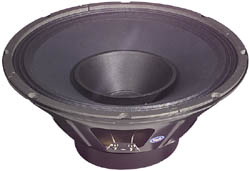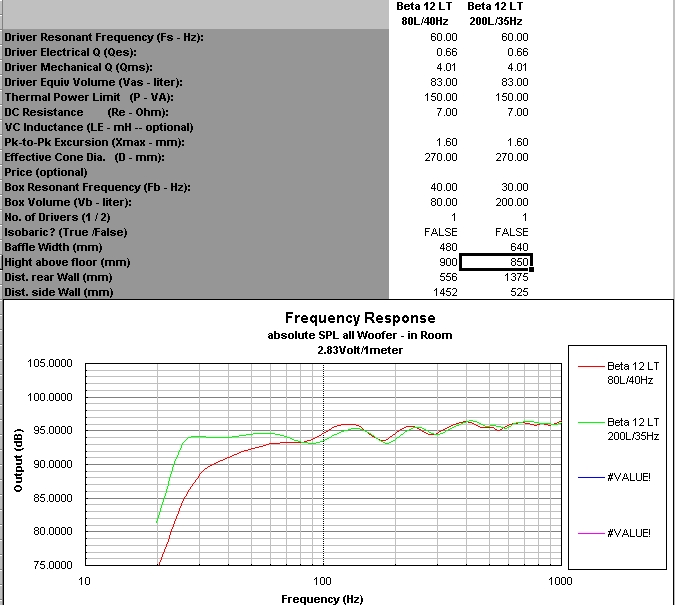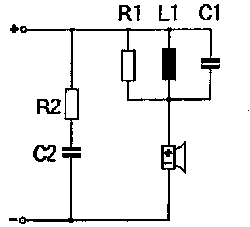
The Afterburner Files
The "Afterburner" is not strictly a project of mine. In fact, I have not myself build this Speaker at all. This project came out of a technical discussion of high efficiency Speakers for DIY. With both inexpensive commercial and DIY KIT Single Ended Amplifiers available you can get something like 3 to 10 really good high quality watts fairly inexpensively. As this is clearly underpowered for most modern so called "High Fidelity" Speakers many people have been discussing some inexpensive way to make some sort of Speakers with high sensitivity and decent bandwidth. Well, my take on such a cheap Speaker was described and turned into the "Afterburner" design. This is a simple to make and inexpensive DIY Speaker with highish sensitivity (in the 96db/W/m region) that works quite well. I know of at least three or four people who did build the Speaker and no-one came back to me yet and said: "I build the speaker as instructed and it's rubbish", in fact those who tried liked the results quite well.
I should add that we are really dealing here with a VERY CHEAP TRICK. This speaker should not be expected to be the end it all or as truly high fidelity, the drivers are a bit too cheap and nasty for that. Depending upon the Cabinet materials expect around $ 300 - $ 400 cost to make a pair, the Drivers alone will be around $ 200. Simply add a Sun Audio SV-2A3 Amplifier Kit (around $ 1,400) and a decent Frontend and you will have very enjoyable sound.
The Main driver in the Afterburner is a 12" Fullrange Driver from Eminence. This is a fairly inexpensive, fairly high quality Pro Audio driver, designed primarily for Vocal application. This Driver is available for example from Parts Express for around $ 70. With a fundamental resonance of 60Hz and response up to around 10kHz this Driver is able to cover most of the range required for the Reproduction of music and operates throughout the critical range (200Hz - 5kHz) without crossover.

A twin-cone model for full range output in compact P.A. systems. The addition of the second cone gives extended high frequency response up to a useful 10kHz
|
Nominal Basket Diameter |
12",304.8 mm |
|
Impedance |
8 or 16 ohm |
|
Power Rating |
150W rms |
|
Resonance |
60 Hz |
|
Usable Frequency Range |
50 Hz - 10 kHz |
|
Average Sensitivity 1W @ 1m |
99 dB |
|
Magnet Weight |
38 oz |
|
Magnet Gap Depth |
0.312", 8 mm |
|
Voice Coil Diameter |
2", 50.8 mm |
Mounting Information
|
Overall Diameter |
12.187", 309 mm |
|
Baffle Hole Diameter |
11.187",284.2 mm |
|
Front Sealing Gasket |
fitted as standard |
|
Rear Sealing Gasket |
fitted as standard |
|
Mounting Holes Diameter |
0.275", 7 mm |
|
Mounting Hole P.C.D. |
11.562",293.7 mm |
|
Depth |
4.47", 113.5 mm |
|
Weight |
6.77 lbs, 3.08 kg |
|
Shipping Weight |
9.6 lbs, 4.36 kg |
Thiele-Small Parameters
|
Resonant Frequency |
60 Hz |
|
Impedance (RE) |
6.96 ohm |
|
Coil Inductance (Le) |
0.89 mH |
|
Electromagnetic Q (Qes) |
0.66 |
|
Mechanical Q (Qms) |
4.01 |
|
Total Q (Qts) |
0.57 |
|
Compliance Equivalent Volume (Vas) |
82.62 litres |
|
Peak Diaphragm Displacement |
42.26 cc |
|
Mechanical Compliance |
0.19 mm/N |
|
BL Product (BL) |
11.97 T-M |
|
Diaphragm Mass inc. Airload (Mms) |
38.0 grams |
|
Equiv. Resistance of mechanical suspension loss (Rms) |
3.53 N*sec/N |
|
Efficiency Bandwidth Product (EBP) |
90 |
|
Voice Coil Overhang (Xmax) |
0.8 mm |
|
Surface Area of Cone (Sd) |
558.6 cm2 |
|
Impedance at Resonance (Zmax) |
61.6 ohm |
For the Treble I suggest that ideally a Radioshack "add on" Horn-Tweeter in it's own pod is added. It looks very high tekky, japanesey in a cheasy, no in a very cheasy kind of a way. Still, performance is quite good, in fact the Tweeter apparently reaches 40kHz for a -10db point and has good powerhandling and sensitivity.

The official data provided on this unit is as follows:
|
Type |
Dome |
|
Diameter |
10/16 in. |
|
Diaphragm Material |
Aluminium |
|
Voice Coil Diameter |
10/16 in. |
|
Voice Coil Impedance |
8 ohms at 9 kHz |
|
Magnet Type |
60 x 8 |
|
Crossover Type |
L - C Cut Net Work |
|
Sound Pressure Level |
96 dB +/- 2 dB |
|
Operation (Sine Wave) |
3 V at 10 kHz |
|
Magnet Weight |
2.86 oz (81g) |
|
Speaker Weight |
22.8 oz (646g) |
|
Power Handling Capacity |
50 Watts maximum music power |
|
Frequency Response |
5000 Hz to 40 kHz +/- 10 dB |
|
Impedance |
8 ohms, +/- 15% at 6 kHz, 1.0 volt |
In the original Unit the Binding Posts are bad and the crossover capacitor is really bad. Nothing to worry, a 1uF to 2uF High quality Capacitor (Hoveland Musicap, Jensen Paper/Oil or whatever you favour) replaces the stock capacitor, Speakercables are best hard soldered. Otherwise rewire the Pod internally with solidcore copper wire which should extend directly all the way to the OUTSIDE of the enclosure leading to the Binding posts. Then use the Binding Posts only to clamp this internal wire to the external Speakercable, you will be surprised by the effect bypassing binding posts has.
By the way, the tip for bypassing binding posts came from www.tweakaudio.com. I found this to be a major improvement, I use this system of Speakercable connection now on both Amplifiers and Speakers.
The Eminence Beta 12 LT driver will operate in a 80 to 100 Liter Box tuned to 40 Hz in such a way that at least 40Hz in room are achievable. No - the tuning is not any maximum flat alignment, it's extended bass shelf and will rely in the speakers being fairly close to rear and sidewalls to make up some sensitivity in the lower octaves. I would suggest something like 75cm X 48cm X 30cm (HWD) outer size. Use 22mm Plywood or solid wood and have a port tuned to around 40Hz. The wide baffle is needed for correct wavelaunch, so please don't make a narrower cabinet. If you are not sure how to build suitable enclosures, please visit Yuichi Arai's Website for a most excellent tutorial how to make suitable enclosures.
I have included here a screenshot from my "Excelbox" Software that includes the response from a speaker as suggested above and on a 60cm high open Stand, similar to those employed by Redheko. For comparison I have also plotted a corner loaded 200 Liter Reflex Enclosure as suggested by Goodmans for their range of 12" Fullrange drivers from the 1960's.

As can be seen, the smaller "standmounted" enclosure offers around 50Hz -3db, 35Hz -6db and 25Hz -10db. Such a response is especially good in smaller rooms that are subject to many room resonance's in close proximity to each other and in the "midbass". The smaller enclosure will sound balanced and "fast" in such rooms, without overhang or boom.
The large cornerloaded Reflex Box however allows around 25Hz -3db to be reached in room if the Speaker is left near a sidewall but moved around 1.5m forward from the rear wall. In a large enough room where the room does not suffer strong bass resonances such a system could provide tremendous bass quality.
Please observe that in both cases the Driver is placed unusually high and that further the distances from the drivercenter to floor, rear and sidewall follow the "golden ratio", this results in the smoothest, most even roomrelated LF boost. If you feel like it, download the Spreadsheet (Excel 97 required) and play around with Box sizes, tuning and room placement.
Furthermore, the Speaker in the smaller box offers a mechanical limit to power handling of 25 Watt above 35Hz and rapidly looses it below. In the large Box the power handling is down only around 12W, but remains at these 12W down to 25Hz.
While one can obviously build the Box, mount the Driver, plonk the Supertweeter on top and play music I personally would suggest some added care and some modifications to the Eminence Fullrange Driver, to improve the sound further.
For one, as the chassis on this inexpensive driver is pressed steel, it is highly recommended to mount the driver in a Fulcrum by the magnet, reducing the sonic problems from the flimsy basket. With the Magnet supported by the basket from the Box the actual movement of the cone will shift the basket and magnet position slightly, enough to introduce audible coloration's and to loose small sound detail. As the specific approach to doing this will depend upon your skills and available tools and materials I cannot be overly specific. The idea is to support the entire driver from the Magnet, so that the magnet is rigidly coupled to enclosure, so the only thing that moves around is the Drivers cone.
In the simplest fashion one could use a piece of solid wood, 4" X 4" and long enough to reach from the drivers magnet to the rearwall of the enclosure and to epoxy the driver in place. This is of course not reversible, so if you do that make sure you have everything working properly and tuned. It is probably a good idea to dampen the basket with Lead and Bitumen too.
The use of additional electrical networks to improve both impedance and frequency response is optional, but recommended. I do not have any specific tested suggestions. Using the notch network and Zobel Circuit from the Hammer Dynamics Speakerkit will be a good starting point.
The Hammer Dynamics "Super 12" driver is a substantially modified version of the Eminence Beta 12 with changes in voicecoil and cone materials among others, however the fundamental cone/whizzer geometry is very similar, thus causing similar unwanted resonance's. Hence the correction circuit will not make for an exact match, but will likely be close. Varying the Resistor R1 allows one to adjust the degree by which the upper midrange is reduced to taste.

The Values for a good starting point are:
R1 - 8R2 10W
R2 - 6R8 10W
C1 - 4uF7 in parallel with 3uF9
C2 - 22uF
L1 - 0mH65
Another option to reduce the sonic problems of the Driver involves taking a leaf from our japanese friends and from Marc Wauters but also from Warfdale we tweak the driver itself a little more.
Paint the cone with Dammer paint. Use a lot of thinner on the first coats and apply the stuff VERY VERY thin.... Apply at least four of five VERY THIN coats to the Whizzer, apply two coats to the cone for starters, too much Dammar and the Driver will not sound so good. This makes the cone stiffer but also makes for more natural sound (don't ask me why - it just does it).
Some of the basic Idea is the same as with the C37 Laquer from Mr. Ennemoser. Lacquering the Speaker with dammar varnish (a clear varnish for oil paintings which is based on natural resin - get it at your arts and crafts supply shop) produces major improvements. However the C37 is again much better than Dammar and if money where no object would be my personal recommendation. Yet this is meant to be a cheap project and enough of the C37 Lacquer to treat the Eminence fullrange Driver will cost more than the Speaker itself.
Hence my recommendation to use Dammar on these drivers to obtain some improvement. Again, I cannot recommend C37 lacquer too highly (in my own system EVERYTHING that can be lacquered is lacquered, from the Speaker Enclosures to the Phono Cartridges cantilever) however it comes at a price. The choice is yours.
Now for one of the best Ideas drivers using a Whizzer cone. Take some foam which is intended for air conditioner filters and adhere it to the rear side of the Wizzer cone covering most of the Whizzer. Marc Wauters suggests a different not permanent approach for Lowthers - but here we are just messing around with cheap PA Drivers, so we might as well glue the stuff down. You want a layer of foam stuck to the rear of the Whizzer. Use very little glue and make sure the glue does not "eat" the foam. The Foam damps the resonance between whizzer and cone, alleviating some of the midrange nasties usually found with Drivers employing whizzers.
Removing the dustacp is often also a good Idea. Then making a "phaseplug" and adhearing it to the polepiece will bring further rewards. Anything of a suitable diamension and aerodynamic shape can be used as phaseplug. I have recommended plastic Easter egg shells filled with plaster of paris for this. One could turn something from solid wood, the options are endless. Use your imagination.
For the tweeter, this should really be timealigned. Use some noise from FM radio between stations and have someone else move the Tweeter forward and backward with you in the listening position until the noise "locks in" (you will know what I mean when it happens).
The FFRC Cable described in TNT-Audio (soon also on this website with updates) lends itself for bi-wiring such a speaker, so make one Set of these while you are at it. Those Cat 5 solid cores cable (best plenum rated with teflon insulation) are also good for the internal wire of the speakers. On the www.tweakaudio.com you can find a good tip on how to bypass the Binding Posts on speakers, use it here....
Why is this speaker called Afterburner? Simple. I like ZZ-Top, and given that this speaker gives low powered Amplifiers a kick (so to speak an afterburner) it has to be. ZZ-Top fan's, play it at MACH 2 on Spinal Tap. It WILL go to Mach 2 even with a Zen Amp from Decware.... Remember my Volume controll goes all the way to 11!
There have been HiFi Versions of such Systems as the one described above, made by Goodmans (Axiom Drivers like the Axiom 80 and Axiom 201) or Electrovoice (SP Series).... Such old Drivers tend to fetch handsome amounts of money in Japan, though they have occasionally been sighted on E-Bay.... As shown above, you could basically drop a Goodmans Axiom 201 or a Axiom 301 or one of the rare Triaxiom 212 into the Box as a later upgrade if and when you can locate a pair of the drivers.
During the time the original idea was hatched I was useing a Goodmans Axiom 201 12" Full Range and a very nice German supertweeter per side in an enclosure with exactly the dimensions described. And yes, the cone was laquered, not with Dammer but with C37 laquer. This system sounded at least as good as the Lowters it replaced in the Midrange but the bass is tons better and some of the remaining Lowther Problems (yes even with Beauhorn Virtuosos there are remaining problems) are simply no longer there.
I have since then changed the Speaker over to the "Magnificat" Design which is better again, but as a reasonably cheap Speaker with high sensitivity the "Afterburner" or a similar system will do splendidly.